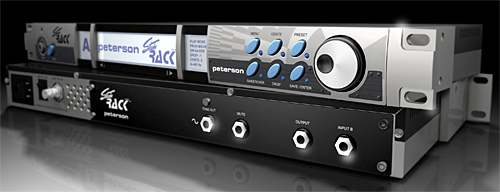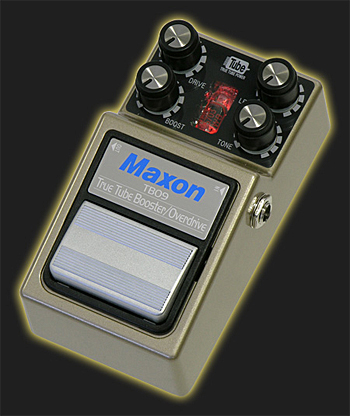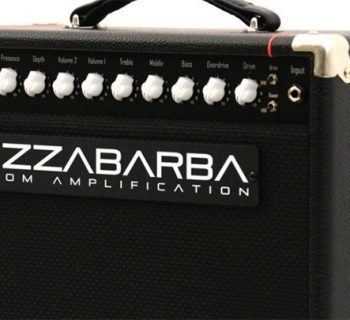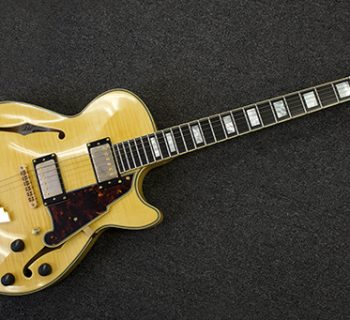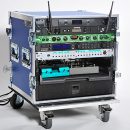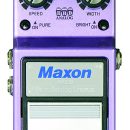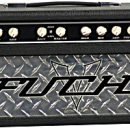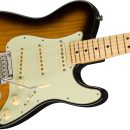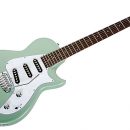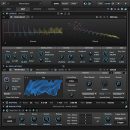 In today’s world, more and more musicians are in need of flexible tuning devices. From a guitarist’s standpoint, the options are endless – Equal Temperament, Drop D, DADGAD, Buzz Feiten tuning systems, etc. To accommodate multiple tuning options, a standard tuner just won’t cut it. And lets not forget about intonation adjustments, either!
In today’s world, more and more musicians are in need of flexible tuning devices. From a guitarist’s standpoint, the options are endless – Equal Temperament, Drop D, DADGAD, Buzz Feiten tuning systems, etc. To accommodate multiple tuning options, a standard tuner just won’t cut it. And lets not forget about intonation adjustments, either!
The Peterson VS-R Virtual StroboRack provides the flexibility needed for multiple tuning options, all at your fingertips via programmable user presets. It’s not just for guitar, either. This tuner will accommodate just about any instrument you can throw at it. And if your mother didn’t tell you everything you need to know about tuning, you’re going to want to read the in-depth User’s Manual explaining Temperaments and Tuning Sweeteners, sure to make your instrument breathe a new life.
| Category | Value | Rating |
| Features | 20% | |
| Usability | 25% | |
| Sound | 25% | |
| Documentation & Support | 10% | |
| Price | 20% | |
| OVERALL RATING = 3.6, which earns a WIHO Award! 3.6 stars or better: Outstanding, WIHO Award 3 stars or better: Worth considering 2 stars or better: Suited to specific needs 1 star or less: Not recommended |
||
Features
The Peterson VS-R StroboRack provides a wide range of features that allow you the flexibility to customize your tuning preferences and store them for instant recall no matter what your choice of instrument is.
The front panel provides all functional features including instrument input, a mute button; Note/Octave LED display (visual representation of the note you’re playing); strobe LED display (for tuning and intonating); a separate menu display; and buttons and a data wheel for operation. Additionally, there’s an onboard microphone for tuning acoustic instruments in a quiet listening environment.
All connections on the Peterson VS-R StroboRack are via ¼ inch Tip/Sleeve. The input connection is available on both the front panel and the rear panel. This is ideal for placing the tuner in your instrument rack, where it will most likely be connected in the rear to a switching system or input from a wireless receiver. The front panel input automatically overrides the rear, so when you’re back in your studio, you can plug in a cable to directly access the tuner without having to tear your rig apart.
The real-time strobe display provides tuning accuracy within 0.1 cent, an extremely fine detail that may take some getting used to when tuning.
Up to eight user settings can be saved, so the tuner can respond appropriately when you plug in your baritone, your seven-string guitar, your six-string that uses Buzz Feiten tuning, and so on.
Thirty-three preset temperaments and sweeteners make this a great tuner for use with orchestral instruments, too.
Other connections on the rear panel are Output (instrument signal), Tone Out (to provide reference tones for other instruments to tune to), and a jack for using typical TS switches for activating the mute function.
A BNC gooseneck lamp socket with On/Off switch is provided on the rear of the unit for rack applications. This was a nice (surprising) extra, especially handy if you have a tiny rack setup that doesn’t include a line conditioner with an optional lamp.
In addition to the BNC bonus, the tuner also provides a user-customizable scrolling marquee! You can have lots of fun with messages scrolling across your rack gear while the band plays on. Who says a tuner has to be boring?
StroboRack accepts any voltage between 95 and 250VAC – automatic detection, so it’s right at home with the international touring artist.
 An optional SR-EX module expands the tuner in ways that no other tuner approaches. The replacement rear-panel interface provides mono, stereo, and balanced connections with an onboard active DI. If you play a hybrid acoustic/electric guitar with stereo outputs, or one magnetic and one piezo output, this option enables you to connect both instrument outputs to the tuner, provides a DI for the acoustic output, and adds footswitch control for selecting instrument outputs and individual muting. Have a premium bass with an XLR output? No problem! Plug into the tuner, then take a quarter-inch output into the rest of your bass rig. So many options with this expansion module!
An optional SR-EX module expands the tuner in ways that no other tuner approaches. The replacement rear-panel interface provides mono, stereo, and balanced connections with an onboard active DI. If you play a hybrid acoustic/electric guitar with stereo outputs, or one magnetic and one piezo output, this option enables you to connect both instrument outputs to the tuner, provides a DI for the acoustic output, and adds footswitch control for selecting instrument outputs and individual muting. Have a premium bass with an XLR output? No problem! Plug into the tuner, then take a quarter-inch output into the rest of your bass rig. So many options with this expansion module!
Usability
If you’re considering the Peterson VS-R tuner, you’re probably a pro level individual looking for an uncompromised tuning and intonation tool, and are probably no stranger to rack equipment. But even less experienced players can rejoice at the ease of use of this tuner. If you know how to use a cell phone or play a favorite video game, you can navigate the Peterson VS-R StroboRack – it’s that easy. (Then again, many of us are still challenged by our cell phones, DVD players, and TV remotes, and may need to consult our children for assistance.)
The displays on the Peterson VS-R Tuner are very easy to read due in part to their size. The first display provides the note being played, sharp or flat indication, and also provides the range of the octave. The second display provides the actual strobe function of the tuner. In the event a note is flat, the strobe will move to the left – a sharp note will move to the right. The speed at which the strobe moves illustrates how sharp or flat the note is. A fast strobe rate represents increased amounts of out-of-tune; a still-standing strobe represents in tune. It reminded us of calibrating our old Technics turntables. If you ever did that, you’ll be right at home with stroboscopic tuning. The third display contains Menu and Menu Page options.
The menu buttons provide simple guidance for directing you to exactly what you want to do. Engaging a menu button activates a blue LED making it simple to determine what function you are in. In programming a preset, using the Menu Buttons and Data Wheel to change values is simple. The menu guided us through each process, step by step.
The features of the tuner are very well marked using white lettering against a black background and black letters against a silver background.
Besides tuning a variety of electric guitars, we were also able to tune an acoustic guitar using the onboard microphone. Note that with no instruments patched into the tuner, you have to engage the Mute button for the onboard microphone to start listening to your acoustic tuning, but with electric instruments patched into the VS-R, the note tracking will display whether or not you’re muted.
We also tried using the onboard mic with an acoustic upright piano. It successfully tracked pitch across most of the piano, but failed to hear notes played in the topmost two octaves. For that purpose, we would suggest connecting an external microphone to the Expander option, which will do a better job eliminating ambient background noise.
It was very easy to program the scrolling marquee in the VS-R. We put our band name in there during testing, but feel free to be a little more “rock-n-roll” with your creative stage messages.
Sound
Some players insist on running their tuners in side chains or switchable loops, but just as many players leave their tuners in-line in their rigs. We’re happy to report that there is no problem doing that with the VS-R. We used it both in the effects loop as well as in front of our Bogner Ecstasy and didn’t notice any difference in our tone or playability.
The Peterson tuner isn’t a silent device, though… it provides audible pitch for tuning, too! That’s right — the Peterson VS-R is supplied with a Tone Out ¼ inch connection for actual instrument-to-pitch tuning. We found the pitch to be clear and consistent – it reminded us of the simple sign wave tones you hear when you get your hearing checked. The quality of the tone was excellent and would mix well with a multitude of instruments capable of spanning multiple octaves.
Documentation and Product Support
The Peterson VS-R came with a very comprehensive User Manual. From explanation of control features and a review of each menu page, to complete set-up and connection options, and best practices for tuning your specific instrument, Peterson left no stone unturned.
We found the illustrations to be clear and concise and really appreciated the detail in explanation, and direction in accomplishing best tuning results. Peterson made sure to address every tunable instrument along with any varying applications – for example, using a sweetened bass guitar tuning to compliment the characteristics of a tuned piano.
There was also interesting history regarding Temperaments and where they originated. In addition, the Peterson website provides support through a variety of customer services options and discussion groups.
Price
The Peterson VS-R StroboRack ($549 MSRP) sells for $360 at retail. The StroboRack Pro Expander adds another $100. Considering their long-standing reputation for accuracy, ability to preprogram multiple tuning configurations along with the sweetening option for pitch customization, we found this tuner to be worth the expense if you are actually going to use all of the available options. But if you’re looking for a basic tuner, this unit may be more than you require.
Contact Information
Peterson Electro-Musical Products, Inc.
www.PetersonTuners.com
| Evaluation Short-List |
|

